Introduction to Wrangell-St. Elias National Park
Wrangell-St. Elias National Park and Preserve is a vast, untamed wilderness in Alaska, a place of immense scale and breathtaking beauty. It is a land of superlatives, home to some of the largest mountains and glaciers in North America.
Overview of the Park’s Size and Significance
At a staggering 13.2 million acres, Wrangell-St. Elias National Park is the largest national park in the United States, about the size of Yellowstone National Park and Switzerland combined. Its sheer scale is difficult to comprehend. The park is a critical component of a larger protected area that also includes Glacier Bay National Park and Preserve, Tatshenshini-Alsek Provincial Park in British Columbia, and Kluane National Park and Reserve in the Yukon. Together, these form the largest internationally protected wilderness on the planet.
Why It’s Called the “Mountain Kingdom of North America”
The nickname “Mountain Kingdom” is well-deserved. The park is home to nine of the 16 highest peaks in the United States, including the towering Mount St. Elias, which at 18,008 feet (5,489 meters), is the second-highest peak in both the United States and Canada. The Wrangell Mountains, an immense volcanic range, dominate the landscape. These dramatic peaks, along with the St. Elias Mountains, create a stunning alpine environment crisscrossed by massive glaciers, making it a dream destination for mountaineers and backcountry adventurers.
UNESCO World Heritage Site Recognition
In recognition of its outstanding natural features, Wrangell-St. Elias National Park was designated a UNESCO World Heritage Site in 1979. This prestigious status highlights the park’s importance for global conservation, particularly for its active tectonic and glacial processes, as well as its rich biodiversity. The World Heritage Site designation underscores its role as a key natural laboratory for scientific study.
Table of Contents
History of Wrangell-St. Elias National Park
The history of Wrangell-St. Elias National Park is a rich tapestry of Indigenous heritage, rugged exploration, and a legacy of conservation.
Indigenous Heritage and Early Settlers
For thousands of years, the land now protected by the park has been the ancestral home of several Indigenous groups, including the Ahtna, Eyak, and Upper Tanana peoples. These groups were skilled hunters and traders, living in close harmony with the land. They traveled vast distances for sustenance, following caribou herds and fishing for salmon. While their traditional lifestyles were dramatically altered by the arrival of Europeans, their cultural legacy remains a vital part of the region’s story.
Mining and Exploration Era
The late 19th and early 20th centuries saw a gold rush in the area, followed by the discovery of one of the world’s richest copper deposits at Kennecott. This led to the construction of the Copper River and Northwestern Railway, a remarkable feat of engineering that stretched through the treacherous wilderness to connect the mines to the port of Cordova. The mining towns of Kennecott and McCarthy became bustling hubs of activity, leaving behind a fascinating historical record of a short but intense era of industrial exploitation.
Establishment as a National Park and Preserve
The end of the mining boom in the 1930s allowed the landscape to begin to reclaim itself. The movement to protect this vast wilderness gained momentum in the 1970s. The region was a key focus of the Alaska Native Claims Settlement Act and the subsequent Alaska National Interest Lands Conservation Act (ANILCA), signed into law in 1980. ANILCA created Wrangell-St. Elias as a National Park and Preserve. The “Preserve” designation allows for activities like hunting and trapping, which are traditional to the region and are prohibited in the “Park” portion of the land. This dual status was a compromise to balance conservation with local traditions.
Geography and Landscape
The geography of Wrangell-St. Elias National Park is a testament to the powerful forces of plate tectonics, volcanism, and glaciation. The park’s immense size means it encompasses a wide range of landscapes, from lush coastal forests to frigid alpine environments.
Mountain Ranges and Glaciers
Wrangell-St. Elias National Park is defined by the convergence of four major mountain ranges: the Wrangell Mountains, the St. Elias Mountains, the Chugach Range, and the eastern portion of the Alaska Range. This unique meeting of ranges creates a landscape of unparalleled mountain grandeur. The Wrangell Mountains, in particular, are almost entirely volcanic in origin and home to Mount Wrangell, one of the largest active volcanoes in North America.
The park holds the greatest concentration of glaciers in North America. These rivers of ice carve the landscape and feed the region’s massive river systems.
- Hubbard Glacier: Located in the park’s eastern region, this is the largest tidewater glacier in North America. It is famously known for its rapid advance and dramatic calving events into Disenchantment Bay, making it a popular destination for cruise ships.
- Malaspina Glacier: Found at the base of the St. Elias Mountains, the Malaspina is the largest piedmont glacier in North America. It’s a vast lobe of ice that sprawls over the coastal plain, with a unique, convoluted surface of moraines.
Rivers and Lakes
Wrangell-St. Elias National park’s immense mountain ranges and glaciers are the source of some of Alaska’s most significant watersheds.
- Copper River System: The Copper River is the largest river in the park, beginning at the Copper Glacier and flowing for 290 miles to the Gulf of Alaska. It is an extremely important salmon spawning ground and serves as a vital artery for the region, forming the park’s western boundary. The river’s tributaries, including the Chitina and Kennicott rivers, are essential for both wildlife and human activity.
- Scenic Lakes and Wetlands: Wrangell-St. Elias National Park is dotted with countless lakes, ponds, and wetlands, many of which are a result of glacial activity. Glacially carved valleys have filled with water, creating pristine, isolated lakes that offer spectacular views. These wetlands are crucial habitats for migratory birds and other wildlife, adding to the park’s incredible biodiversity.
Wildlife and Ecosystem
Despite its rugged and seemingly harsh environment, Wrangell-St. Elias National Park is a haven for an incredible diversity of wildlife, thanks to its range of habitats from coast to interior.
Mammals
Wrangell-St. Elias National park’s vast size provides ample space for large mammals to roam freely, making it a critical area for their long-term survival.
- Grizzly bears and black bears: Both species are present in the park, inhabiting different elevations and territories. Grizzlies are often found in open alpine areas and along salmon-rich rivers, while black bears prefer forested regions.
- Moose: These solitary giants are commonly found in the park’s lowlands and wetlands, where they browse on willows and other vegetation.
- Caribou: The Mentasta and Nelchina herds migrate through the park, a magnificent spectacle of the region’s wilderness.
- Dall sheep and mountain goats: These hardy creatures are often seen on the high, rocky slopes of the park’s mountains, perfectly adapted to a life of precarious climbing. Wrangell-St. Elias National Park is home to one of the largest concentrations of Dall sheep in North America.
Birds
Wrangell-St. Elias National Park is a paradise for birdwatchers, with over 200 species of birds, many of which are migratory.
- Bald Eagles: The national bird is a common sight, soaring high above the rivers and coastlines in search of fish.
- Trumpeter Swans: These majestic waterfowl nest in the park’s ponds and wetlands, their distinct calls echoing across the quiet landscape.
- Migratory species: Wrangell-St. Elias National park’s coastal areas and vast wetlands provide critical stopover points for thousands of birds traveling the Pacific Flyway, including a variety of ducks, geese, and shorebirds.
Plant Life
The vegetation of Wrangell-St. Elias National Park varies dramatically with elevation and location, creating a rich tapestry of plant life.
- Alpine Tundra: In the higher elevations, above the tree line, the landscape is dominated by alpine tundra. This harsh environment is home to a surprising array of wildflowers, lichens, and mosses that hug the ground, including dwarf birch, willow, and crowberry.
- Boreal Forest: The interior lowlands are covered by boreal forest, or taiga, composed primarily of black spruce and white spruce trees. This dense forest is punctuated by bogs, wetlands, and small lakes.
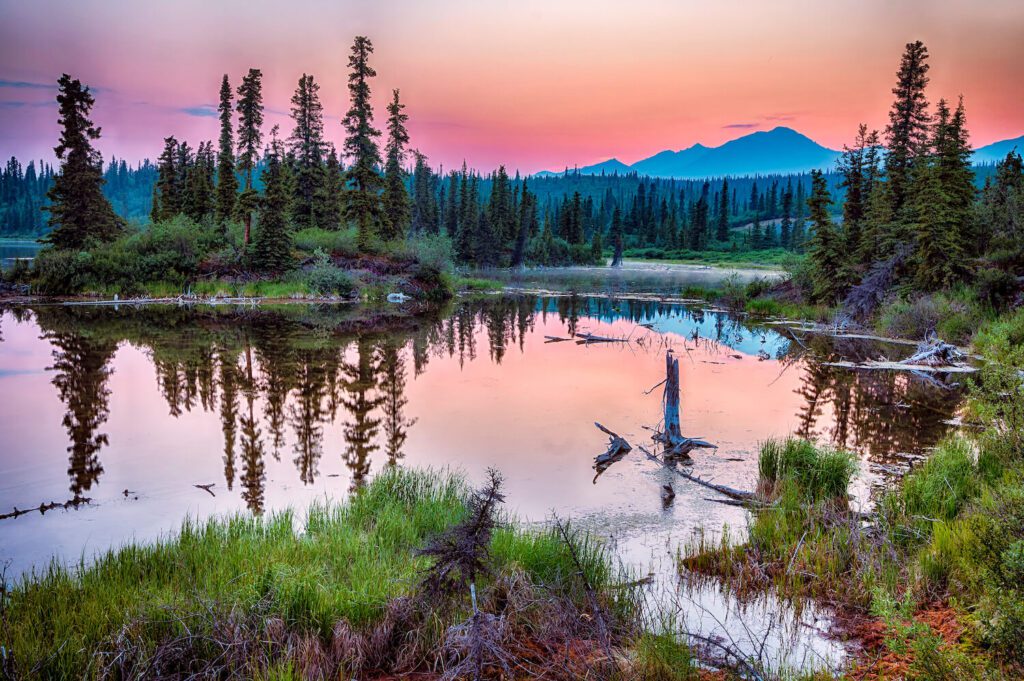
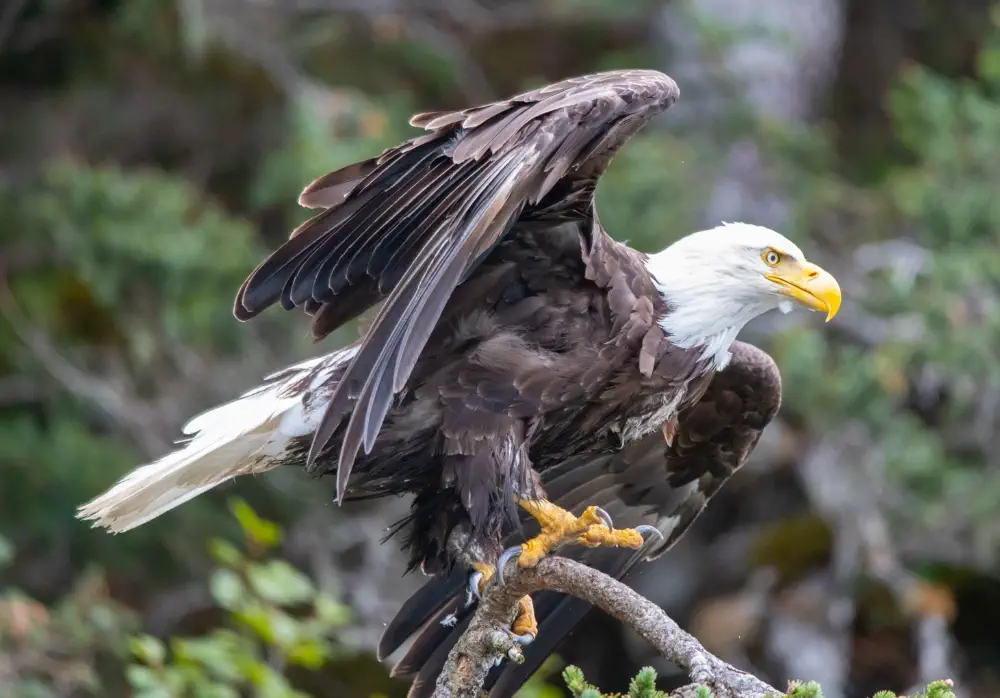
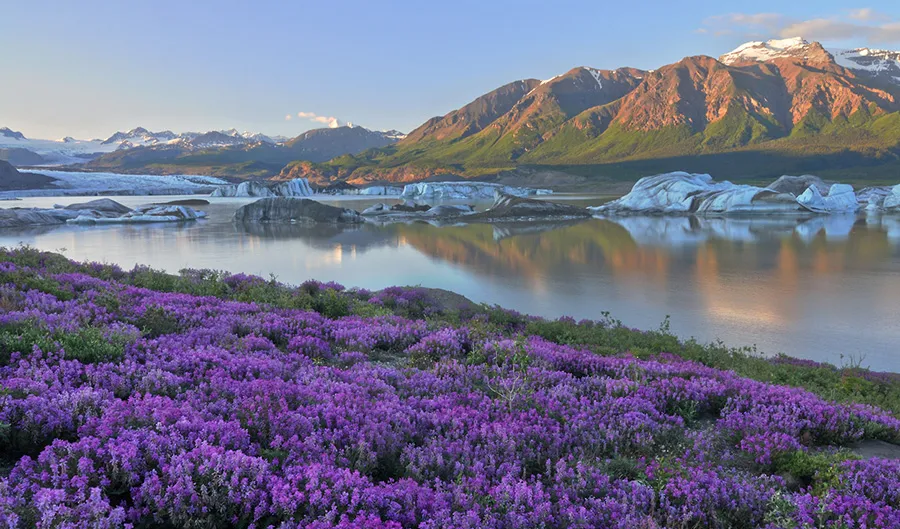
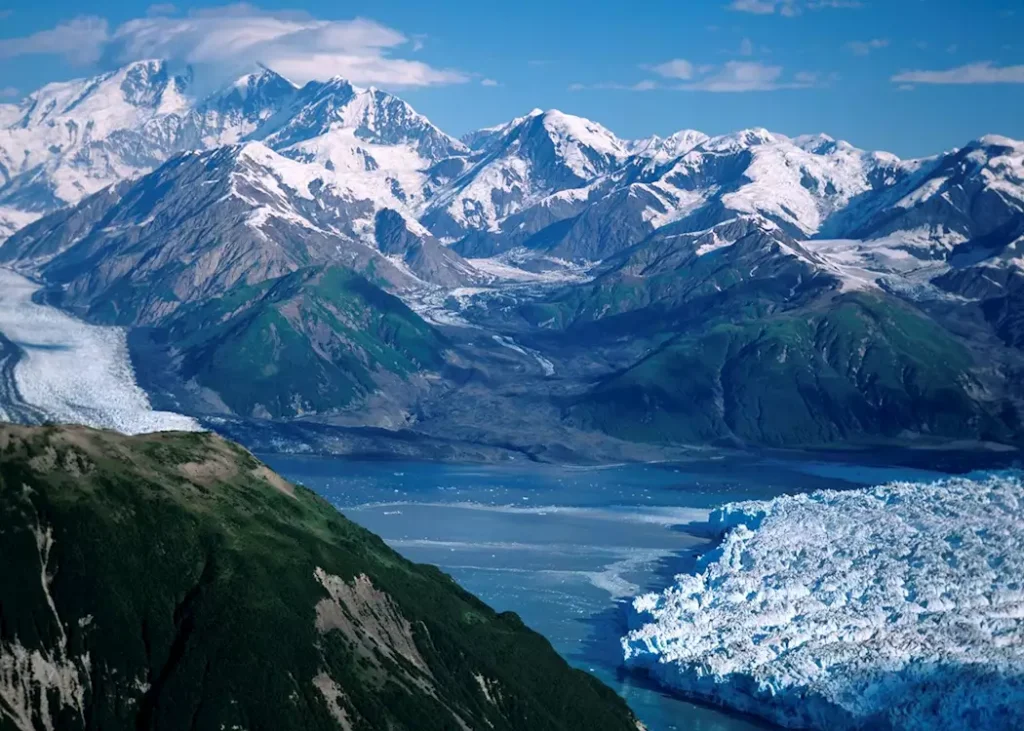
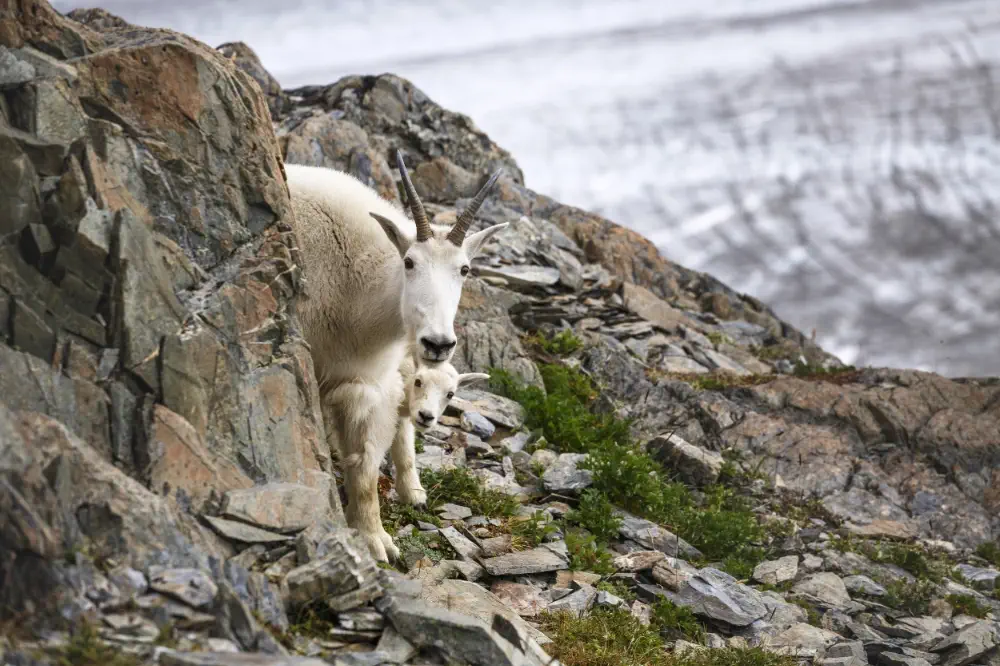
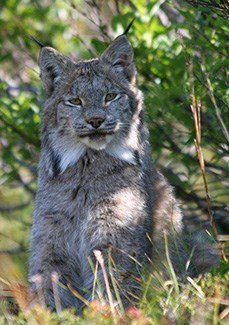
Things to Do in Wrangell-St. Elias National Park
Unlike more developed national parks, Wrangell-St. Elias National Park is a true wilderness that offers a more self-reliant and immersive experience. Its two main access points, the Nabesna and McCarthy roads, lead to a world of adventure.
Hiking and Backpacking Trails
While Wrangell-St. Elias National Park is known for its trail-less backcountry, there are a few established trails that offer incredible views and a taste of the wilderness.
- Root Glacier Trail: This is arguably the most popular and accessible hike in the park. Starting near the historic town of Kennecott, the trail is a relatively easy 4-mile (one-way) hike along the lateral moraine of the Root Glacier. It leads hikers directly onto the ice, where they can explore its surface (with proper gear like crampons) and witness stunning features like blue pools and moulins (vertical shafts in the ice). Many guided tours are available for those who want to hike on the glacier.
- Skolai Pass: For a truly epic backcountry adventure, the trek to Skolai Pass is world-renowned. This multi-day journey is typically accessed via a bush plane flight, and it offers some of the most spectacular scenery in Alaska. The trail traverses a mix of tundra, rock, and glaciated terrain, with unparalleled views of towering peaks and deep valleys. It is a strenuous trip that requires significant planning, navigation skills, and a high level of self-sufficiency.
Camping and Backpacking
Wrangell-St. Elias National Park is a backcountry enthusiast’s dream, offering an unparalleled opportunity for true wilderness immersion.
Backcountry Camping Opportunities
The vast majority of the park is open for backcountry camping. There are no designated campsites or trails, meaning you can pitch your tent wherever you choose (following Leave No Trace principles). This freedom allows for a truly personalized adventure, whether you’re backpacking into a remote valley, camping on a glacial moraine, or settling in for a multi-day trek. Backcountry camping here requires a high level of self-sufficiency, as you will be far from any services and will need to be prepared for unpredictable weather and wildlife encounters. It is essential to be proficient in navigation and to carry a satellite communication device for emergencies.
Campgrounds for Visitors
For those who prefer a less remote experience, there are a few established campgrounds. The National Park Service operates Kendesnii Campground on the Nabesna Road, offering 10 designated, free campsites with picnic tables and fire rings. Additionally, there are a few private campgrounds located near the park’s access points, such as the Wrangell View RV Park near the entrance on the Edgerton Highway. In the Kennecott and McCarthy area, there are no official NPS campgrounds, but private landholders offer camping and lodging.
Flightseeing and Air Tours
To truly appreciate the immense scale of Wrangell-St. Elias National Park, a flightseeing tour is an absolute must. From the air, the park’s “mountain kingdom” nickname becomes a breathtaking reality.
Best Ways to See Glaciers and Peaks from Above
Local air taxi operators offer a variety of tours that provide a “bird’s-eye view” of the park. From a small plane, you can witness the confluence of multiple mountain ranges, fly past jagged peaks that pierce the sky, and see the intricate details of massive icefields like the Bagley. Many flights offer spectacular views of the Nabesna Icefield and the Wrangell Volcanoes. A flightseeing tour is the only way for most visitors to see the remote, awe-inspiring beauty of Mount St. Elias. Some tours even include a backcountry landing, allowing you to step out and feel the remote wilderness under your feet.
Fishing, Rafting, and Kayaking
Wrangell-St. Elias National park’s extensive network of rivers and lakes offers countless opportunities for water-based adventures.
Rivers and Lakes for Water Adventures
- Fishing: The Copper River and its tributaries are famous for their salmon runs, offering world-class fishing. Other rivers and lakes in the park are also home to grayling, trout, and other fish species. A valid Alaska fishing license is required.
- Rafting: For the experienced and well-equipped adventurer, rafting is a way to explore the park’s remote interior. The rivers are glacial, with cold, fast-moving water and shifting channels, so a guided trip is highly recommended. Multi-day trips on rivers like the Nizina offer a truly immersive way to see the park.
- Kayaking: In certain lakes and calm river sections, kayaking provides a serene way to explore the landscape from the water level, offering a unique perspective of the surrounding mountains and glaciers.
Visitor Information
Planning a trip to Wrangell-St. Elias National Park is different from visiting a typical national park. The rugged roads and vast distances require careful planning and preparation.
Getting to Wrangell-St. Elias National Park
Wrangell-St. Elias National Park has two primary access points that are accessible by road from Anchorage.
- McCarthy Road: This is the most popular way to access the Wrangell-St. Elias National park’s main visitor hub. It’s a 60-mile (97 km) gravel road that begins in Chitina and ends at the Kennicott River footbridge. The road can be rough, and many rental car companies do not allow their vehicles on it, so be sure to check with your provider. A shuttle service is available in McCarthy to take you across the footbridge to the historic town and the Kennecott Mill.
- Nabesna Road: On the northern side of Wrangell-St. Elias National Park, this 42-mile (68 km) gravel road offers a more remote experience. It is less traveled and provides access to different landscapes, including the Nabesna Icefield. A high-clearance or 4-wheel-drive vehicle is recommended, and services are non-existent along the route.
Airports and Nearby Towns
The closest major airport is Ted Stevens Anchorage International Airport (ANC). From there, you’ll need to rent a car or arrange for a shuttle service to get to Wrangell-St. Elias National park’s access roads. The closest significant towns are Glennallen and Copper Center, which are located on the Richardson Highway near the park’s main visitor center. Both towns offer limited lodging, gas, and supplies. The town of McCarthy at the end of the McCarthy Road is a small, historic community with a few businesses and lodging options for park visitors.
Best Time to Visit
The “best” time to visit Wrangell-St. Elias National Park is highly dependent on the type of experience you’re seeking, as the park offers a dramatically different atmosphere in summer versus winter.
Summer (Late May to Mid-September)
This is the primary season for visitors. The long daylight hours and more moderate temperatures make all activities and access points available.
- Activities: All park facilities, visitor centers, and businesses in McCarthy and Kennecott are open. Hiking, backpacking, flightseeing, and guided glacier tours are in full swing. The roads are clear of snow, making the McCarthy and Nabesna Roads accessible.
- Highlights: The landscape is at its most vibrant. Wildflowers are in bloom, the salmon runs are active in the rivers, and wildlife is abundant. This is the ideal time for first-time visitors who want to experience the Wrangell-St. Elias National park’s iconic features.
Winter (Late September to Early May)
Winter in Wrangell-St. Elias National Park is an extreme but uniquely beautiful time to visit.
- Activities: Wrangell-St. Elias National Park becomes a quiet, snow-covered wonderland. The McCarthy and Nabesna Roads are often closed or unmaintained, so access is limited to snowshoes, cross-country skis, or snowmobiles (“snowmachines” in Alaska). Most services are closed, so self-sufficiency is a must.
- Highlights: The solitude and pristine beauty are the main draws. The landscape is peaceful and silent, with opportunities for aurora borealis (Northern Lights) viewing and a truly rugged, off-grid adventure.
Visitor Centers
Starting your trip at a visitor center is highly recommended to get oriented and learn about Wrangell-St. Elias National park’s unique features and safety requirements.
- Wrangell-St. Elias Visitor Center (Copper Center): This is Wrangell-St. Elias National park’s main visitor center, located outside the park boundaries in Copper Center on the Richardson Highway. It features an impressive exhibit hall, a theater with an informative park film, a park store, and scenic overlooks of the Wrangell Mountains. Park rangers are available to provide trip-planning advice, issue permits, and offer interpretive programs.
- Kennecott Visitor Center: Situated in the heart of the Wrangell-St. Elias National park’s historic district, the Kennecott Visitor Center is housed in the old Kennecott Powerhouse. It offers information on the local area, guided tours of the historic mill town, and access to the Root Glacier Trail.
Lodging and Accommodations
Wrangell-St. Elias National Park offers a range of lodging options, from rustic cabins to modern hotels, though choices are limited and should be booked well in advance.
- Hotels and Lodges: There are a few hotels and lodges in the nearby towns of Glennallen and Copper Center, as well as in the more remote communities of McCarthy and Kennecott. These accommodations range from basic rooms to comfortable, full-service lodges.
- Rustic Cabins and Wilderness Lodges: For a more authentic experience, many small, locally owned wilderness lodges and cabins are scattered throughout the park and its surrounding area. Many of these require access by bush plane, offering an unparalleled level of seclusion.
- Camping Options: In addition to the backcountry camping opportunities, there are a few established campgrounds. The NPS operates a free campground on the Nabesna Road, and several private campgrounds are located near the park entrances.
Travel Tips for Wrangell-St. Elias National Park
Due to the Wrangell-St. Elias National park’s wild and undeveloped nature, a successful trip relies heavily on preparation and a sense of adventure.
Safety in Remote Wilderness
Safety is paramount in this vast and unforgiving landscape.
- Bear Safety: The park is home to both grizzly and black bears. Carry bear spray and know how to use it. Make noise while hiking to avoid surprising a bear, and never store food in your tent. Bear-resistant food containers are required for backcountry camping.
- River Crossings: Be extremely cautious when crossing glacial rivers, as they are often swift, cold, and unpredictable. Unbuckle your pack’s waist and sternum straps before crossing to be able to shed it quickly if you fall.
- Communication: Cell phone service is non-existent. Carry a satellite communication device, such as a satellite phone or a GPS messenger, for emergencies.
What to Pack for Hiking and Camping
Layering is crucial for comfort and safety. Pack waterproof and windproof outerwear, insulating mid-layers, and moisture-wicking base layers. Sturdy, broken-in hiking boots are essential. Bring plenty of water, high-energy snacks, a map, a compass, and a headlamp.
Guided Tours vs. Independent Exploration
The choice between a guided tour and independent exploration depends on your experience level and desired trip style.
- Guided Tours: Hiring a local guide is highly recommended for those with limited wilderness experience or those seeking a more educational trip. Guides provide expertise in navigation, safety, and local knowledge, allowing you to focus on the experience.
- Independent Exploration: This is for experienced adventurers who are comfortable with self-reliance in remote, challenging terrain. Independent exploration offers the freedom to create a personalized itinerary and truly immerse yourself in the park’s solitude.
Wrangell-St. Elias and Nearby Attractions
A visit to Wrangell-St. Elias is often combined with exploring its remarkable neighbors, which are not only geographically close but also share a deep historical and ecological connection.
Kennecott Mines National Historic Landmark
Within the park’s boundaries lies the Kennecott Mines National Historic Landmark, a fascinating glimpse into Alaska’s industrial past. From 1911 to 1938, this was the site of the world’s richest copper deposit. The well-preserved ghost town features the impressive, 14-story Kennecott Mill and numerous other red-and-white buildings, standing as a stark contrast against the backdrop of the Root Glacier and the surrounding mountains. Visitors can take guided tours to learn about the lives of the miners and the incredible feat of engineering that was the Copper River and Northwestern Railway, which was built to transport the ore.
Glacier Bay National Park (as part of UNESCO site)
Wrangell-St. Elias is a key part of the Kluane / Wrangell-St. Elias / Glacier Bay / Tatshenshini-Alsek UNESCO World Heritage Site. This vast, transboundary protected area is one of the largest on Earth. While Wrangell-St. Elias is known for its towering peaks and active volcanoes, Glacier Bay National Park and Preserve is famous for its tidewater glaciers that calve into the sea, its abundant marine life, and its dramatic fjords. The two parks together represent a complete ecological system, from the high, inland icefields that feed the glaciers to the ocean at their terminus, showcasing the full range of glacial processes.
Connection to Yukon’s Kluane National Park
Wrangell-St. Elias shares a border with Kluane National Park and Reserve in Canada’s Yukon Territory. This connection is not just geographical; it is a vital part of the transboundary World Heritage Site. Together, these parks protect the immense St. Elias Mountains, which include Mount Logan (Canada’s highest peak) and Mount St. Elias (the second highest in both nations). The two parks function as a single ecological unit, providing a continuous, protected habitat for wide-ranging species like grizzly bears, wolves, and caribou. This international collaboration is a powerful example of how countries can work together to preserve critical wilderness areas.
Conclusion – Why Wrangell-St. Elias is a Must-See Destination
Wrangell-St. Elias is not a park for the casual tourist; it is a destination for the true adventurer. Its unparalleled size, raw beauty, and sense of untamed wildness offer an experience unlike any other. It is a place where you can witness powerful geological forces at work, explore a rich history of Indigenous culture and mining, and feel the solitude of true wilderness.
By venturing into this magnificent “mountain kingdom,” you are not just a visitor—you are a temporary part of a landscape that humbles you with its scale and inspires you with its resilience. Wrangell-St. Elias stands as a global monument to conservation, a reminder that some places are meant to be preserved in their raw and natural state. It is a place that will challenge you, change you, and leave you with a profound respect for the wild heart of Alaska.

